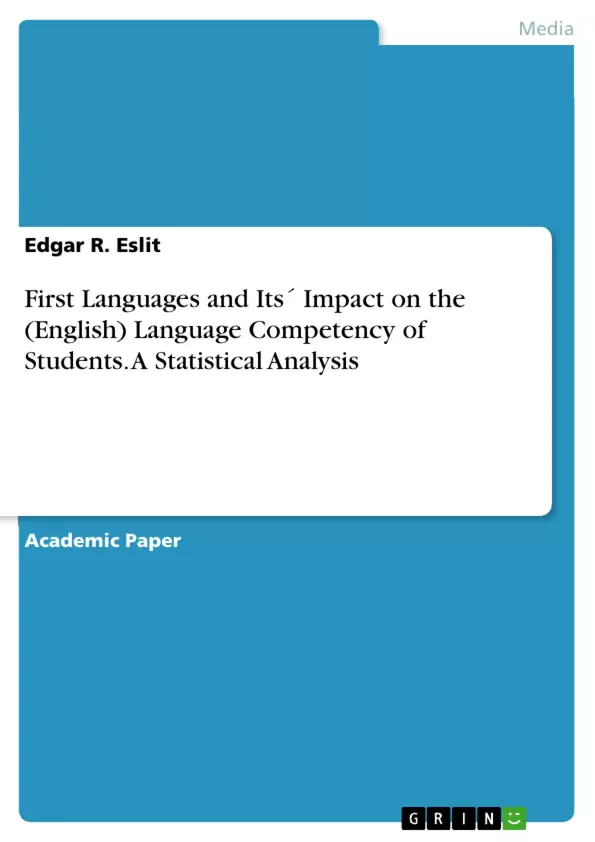This study examines the influence linguistic competence has in learning a second language.
Language use, be it in reading, writing, speaking, and comprehension, requires knowledge of linguistic competence. This knowledge should be tacit and implicit especially among the second language learners. This means that students should have conscious access to the principles and rules that govern the principles used on this particular language. Such idea is akin to the current study. Hence, the purpose of this study was to find out the First Language Influence on the Linguistic Competence of the respondents.
This was carried out among the one hundred sixty three (163) Grade 10 students. The linguistic competence, acculturation, and cognitive academic language proficiency theories served as the theoretical backbone. Both quantitative and qualitative methods were used. Using the purposive sampling procedure, data was collected via an adopted survey questionnaire on first language influence and an IELTS-based test. Mean and standard deviation were observed. These were carried out further using the Spearman – Rho Correlation to measure the strength of association or correlation between the cited variables. Likewise, this test was used to measure the influence of the first language to the linguistic competence in relation to the sampling population as described by the correlation coefficients.
Results revealed that the respondents’ linguistic competence was slightly correlated to the influence of first language. To address the gap, an instructional module was proposed in order to improve the linguistic competence of the respondents.
Table of Contents
- Introduction
- Chapter 1: THE PROBLEM AND ITS SETTING
Objectives and Key Themes
The objective of this study is to investigate the influence of first language on the linguistic competence of Grade 10 students in the Philippines. This research aims to understand the relationship between students' first language use and their English language proficiency, ultimately informing the development of an instructional module to improve English linguistic competence.
- First Language Influence on Second Language Acquisition
- Linguistic Competence in English as a Second Language
- The Role of Language Policy in Educational Attainment
- Development of an Instructional Module to Improve Linguistic Competence
- Correlation between First Language Use and English Proficiency
Chapter Summaries
Chapter 1: THE PROBLEM AND ITS SETTING: This chapter establishes the context for the study by exploring the multifaceted relationship between first language and second language acquisition. It highlights the linguistic diversity of the Philippines, with its 170 languages, and the challenges this presents for English language education. The chapter discusses the existing research on the impact of first language use on second language learning, referencing studies that show the potential benefits of mother tongue instruction while also acknowledging the declining English proficiency in the Philippines. The chapter focuses on the difficulties faced by students at Acelo Badelles Sr. Memorial High School, where the prevalent first language, Cebuano, is observed to negatively impact English language skills. The issue of declining English proficiency in the Philippines, as highlighted by various sources, is central to the chapter's argument for the need for this study.
Keywords
First Language Influence, Linguistic Competence, Instructional Module, Second Language Acquisition, English Language Proficiency, Philippines, Language Policy, Bilingualism.
Frequently Asked Questions: A Comprehensive Language Preview
What is the main objective of this study?
This study investigates how students' first language influences their English language competence in Grade 10 in the Philippines. It aims to understand the relationship between first language use and English proficiency to inform the creation of an instructional module for improving English skills.
What are the key themes explored in this research?
The key themes include the impact of first language on second language acquisition, linguistic competence in English as a second language, the role of language policy in education, the development of an instructional module, and the correlation between first language use and English proficiency.
What is the context of this study, as described in Chapter 1?
Chapter 1 sets the stage by examining the complex relationship between first and second language acquisition in the Philippines, a country with over 170 languages. It discusses the challenges this linguistic diversity presents to English language education, reviewing existing research on the effects of first language use on second language learning. The chapter focuses on the difficulties faced by students at Acelo Badelles Sr. Memorial High School, where Cebuano's prevalence seems to negatively affect English skills. The decline in English proficiency in the Philippines is a central concern, justifying the need for this research.
What are the key words associated with this research?
Key words include: First Language Influence, Linguistic Competence, Instructional Module, Second Language Acquisition, English Language Proficiency, Philippines, Language Policy, and Bilingualism.
What does the provided preview include?
This preview offers a comprehensive overview, including the title (though not explicitly stated here), table of contents, objectives and key themes, chapter summaries, and keywords.
Which chapter is summarized in this preview?
This preview summarizes Chapter 1: THE PROBLEM AND ITS SETTING.
Where can I find more information about this study?
The full text of the study would provide further details and analysis beyond the preview presented here.
- Quote paper
- Edgar R. Eslit (Author), 2019, First Languages and Its´ Impact on the (English) Language Competency of Students. A Statistical Analysis, Munich, GRIN Verlag, https://www.grin.com/document/491327



